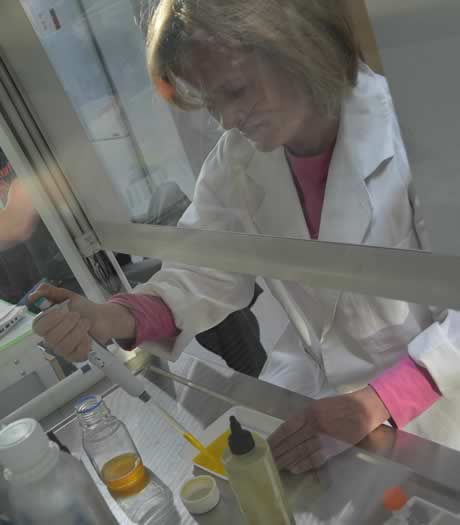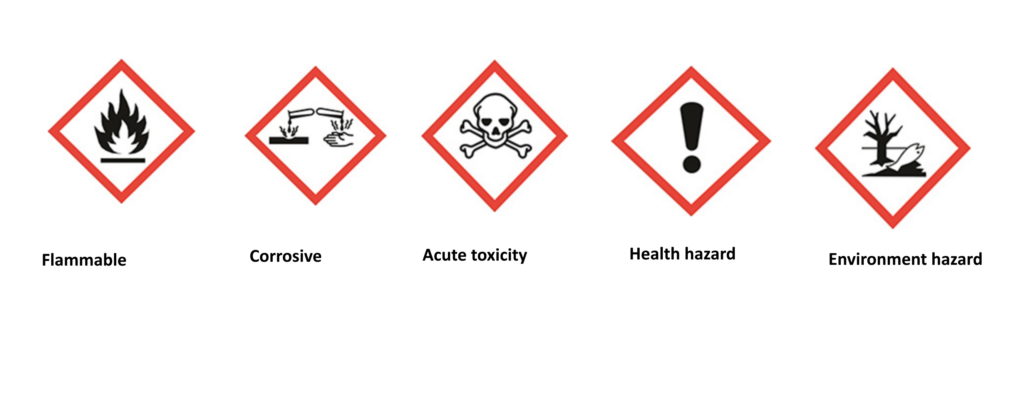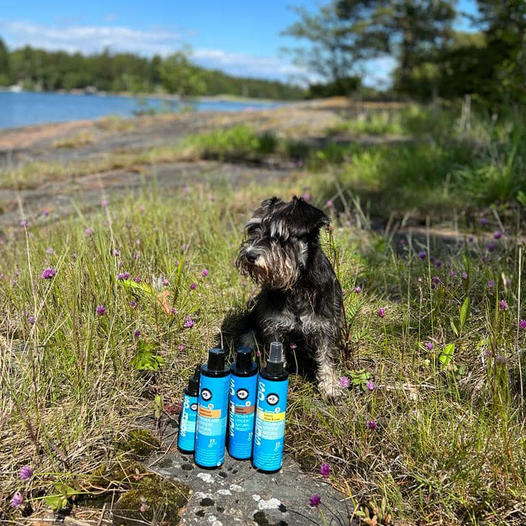Many animal friends are surprised when they find out that animals are considered items or objects under the law. As a consequence, all animal care products are regulated under the chemical legislation (Finnish Safety and Chemicals Agency (TUKES) as supervising agency). This means that the safety of animal care products such as topical rash treatments, ear cleaning products for dogs, shampoos and other similar products, is assessed on the same basis as the water for a car battery or house paint. Medicines are covered under its own pharmaceutical legislation, and cosmetics for humans are covered by the legislation for cosmetics.
Product safety for SOLHEDS’ Derma-product series
Product safety is always our first priority. We select the active ingredients based on scientific proof on their efficacy. We also complete a profile of adverse effects for each raw material, meaning that we investigate its potential harmful side effects or toxicity when used on cats, dogs and horses. All raw materials used in our products have to be suitable for use on the animals we recommend the product is for. Only raw materials that have been chemically analysed and for which the quantities of their active ingredients and fatty acids are known will be used. The microbial sensitivities of the essential oils used in the products also have to be known. The microbial sensitivity indicates at what concentration the essential oil will destroy certain microbes (e.g. bacteria, fungi).
We always use essential oils with a high level of active ingredients in the SOLHEDS Derma products. We never use plant extracts, which have a low level of active ingredients, if an oil is available, since the oil is preferable to the plant extract, while the concentration of active ingredients is several fold higher. We also conduct skin irritation tests with our products and identify the therapeutic window for our raw materials and products. The therapeutic window marks the safe concentration at which the efficacy can be reached.
Thanks to the process described above, we can use the raw materials correctly without causing harm or danger to animals.
SOLHEDS Derma products are generally self-preserving and no preservatives are required thanks to the used ingredients, which guarantees adequate preservation. No thiazolines, benzoates, parabens or other preservatives known to cause skin irritation are used in the SOLHEDS Derma products. It is challenging to formulate products for cats as many substances, especially preservatives, are harmful and even toxic to them. The preservation system in SOLHEDS’ Derma products is safe even for cats. All our products fulfill the strictest requirements under the cosmetics legislation regarding microbial preservation, while also being skin friendly for animals. This has been tested and verified in an accredited external laboratory in the same way human cosmetics are tested.
SOLHEDS Derma products do not contain any ethanol (alcohol) because alcohol dries out the skin and stings. The formulation of our products, meaning its final use form, is designed for animals. The topical creams absorb fast without leaving an oily or fatty surface that collects dirt. Our shampoos rinse off quickly and are skin friendly, without drying out the skin. Our day-to-day use products do not contain any raw materials with strong active ingredients such as high concentrations of essential oils, resin or tar. Strong active ingredients can cause resistant microbes or skin irritation if used wrong. All SOLHEDS products are designed so that their chemical burden on the skin is as low as possible. We adjust the pH so it is suitable for animals by keeping the pH of SOLHEDS Derma products around 7 in products where the pH can be regulated.
Our production facility is adequate for its use and allows for a clean and safe production line. SOLHEDS Derma products are always manufactured using sterile water. We never manufacture or pack our products by hand in order to guarantee cleanliness and product safety. The product cleanliness is always checked using microbial tests.
Scientific proof of our products’ effectiveness can be found on our webpage. This was published during the Finnish Veterinary Days 2015
On the product label you find comprehensive information and instructions for the safe use of the product, and you can find more information on our webpage. The suitability of our packing materials have been tested for their intended uses and for the raw materials. We follow sustainability principles and use recycled materials for our packaging.

At SOLHEDS we do our own product development and thanks to continuous research we find new ways of improving our Derma products and their properties. Behind our products is a combination of high professional competence and years of experience in medical development and care of dogs, cats and horses.
Along with product safety, ecological values are also at the core of our business. Our business model is based on principles of sustainable development, starting at the production line, and not just when it comes to the raw materials. We adhere to the criteria set by both the cosmetics legislation and the ecological certification in our natural products. By investing in ecological values we want to do our part for preserving the planet. For us animal friends it is a no-brainer to focus on product safety. For us, the animal is worth safe and effective care.
What is product safety?
Cosmetic products for humans, meaning products intended for external use such as lotions and shampoos, are subject to the cosmetics legislation. This legislation ensures the product is safe for human use, and authorities (TUKES in Finland) supervise the product safety. This results in for example restrictions on ingredient use to make sure the product is safe for humans. TUKES monitors, among other, the concentration of substances that are restricted or subject to limitations: What you cannot use in products. There are also strict regulations on product shelf life, and the use of preservatives is heavily restricted. The purpose of these restrictions is to ensure the product is safe for human use. A register is kept of various substances and products, and it is monitored. The same guidelines apply to the entire production process, from production premises to packaging and equipment. There is a significant requirement for expertise.
Products safety for animal products, does it exist?
There is no equivalent guarantee of product safety for animal care products. The fact that animal products are in the same position as car battery water means that many harmful and even dangerous substances are legally used in animal products. Strong cleaning agents intended for toilet cleaning and bleaches can be packaged as deep-cleaning shampoos for dogs. A substance poisonous to cats can be used and marketed to cats. It can be exaggeratedly stated that animal products can be made in one’s own bathroom and packed with bare hands into any container of choice. Animal products that are considered cosmetics, i.e. have permission to be marketed to humans, does not provide product safety for the animal, but does for the human user. For example, xylitol is safe and even healthy for humans in cosmetics, but toxic to dogs. Cosmetics legislation only focuses on human well-being. The product safety and level of quality for animal care products is determined by the manufacturer and marketer themselves.
Hazard Chemical warning symbols
The minimum requirement from authorities for product safety is the obligation to use warning symbols. The goal of using symbols is to draw the consumer’s attention to product safety. The most typical warning signs seen in animal care products include:

A warning sign on a product means that the product contains a substance that is flammable, corrosive,… if the concentration of the harmful or dangerous substance in the product is so high that a warning sign is required.
It can be difficult for the consumer to react to the warning sign in the appropriate manner if the product name is, for example, Hypoallergenic shampoo. A corrosive substance warning sign on the side of the product may be overlooked because of the product’s promising name and brand value.
Similar warning signs can be found in products intended for humans, such as nail polish remover, hairspray, and toilet cleaners. This should be kept in mind when considering where animal products fall in terms of product safety. Few people would wash their hair with toilet cleaner or regularly spray hairspray on their skin.
With non-existent requirements for product safety, many manufacturers and marketers of animal products don’t understand the importance of ensuring the safety of the products they manufacture and market, since no one officially requires or monitors it.
Anyone can produce and package their own version of an anti-itch ointment, wherever and however they want, setting their own quality standards.
Natural products and product safety?
Natural products are often mistakenly perceived as safe. Tea tree oil, resin, tar, and many other plant-derived ingredients may sound harmless. However, this is not always the case. Too high concentrations of potent active ingredients in natural raw materials (resin, tar, pitch, essential oils…) also pose a risk to product safety. The use of natural raw materials must be controlled: how they are used, how they can be combined, and what the level of quality must be so that they can be used safely.
It’s extremely important to understand the purity of the natural substances used and how much of the active ingredients they contain. A natural substance is only valuable for its intended use if it contains the exact active ingredients required to achieve the desired effect. Every oil and natural ingredient batch is different. Resin in product X and resin in product Y are two different things.
It is common to see tinctures and extracts, which sounds fancy, on the ingredients list of animal care products. Valuable essential oils are produced, for example, by steam distillation. During the process, the valuable active ingredient-containing oil is separated from the plant. Water is removed as a by-product, containing only a fraction of the active ingredients. The volume of this water by-product from steam distillation is multiple times greater compared to the oil obtained. This water by-product is sold under the name tincture, or extract and contains very scarce amount of active ingredients.
Preservation of natural products is also very challenging by the ample supply of nutrients that they contain for a wide range of microbes, including bacteria.
The growing “green boom” has introduced many new product lines to the market. Trends can be seen in the production and marketing of natural products. Currently (2023) there is an perceived ongoing competition in Finland among manufacturers: whose product contains the highest resin concentration. Approximately 5% of the population is hypersensitive to the resin and experiences an allergic reaction when they come into contact with it. The problem intensifies when the quality of raw materials is compromised.
No active ingredients should be used unnecessarily and casually unless there’s a need for them, as appealing as products like tar, resin, and tea tree oil might sound. The manufacturer again determines their own quality and safety standards for their products.
In cosmetics for humans, it is defined what constitutes a natural product. For instance, the use of petrochemical by-products like paraffin, vaseline, and mineral oil is prohibited in natural products. Unfortunately these ingredients are commonly found in “natural products” for animals. For animal care products, the manufacturer sets their own definition of what constitutes a natural product.
How to choose safe products?
The legislation puts the consumer in a tricky position when it comes to making product choices. Generally product safety testing falls on the consumer, meaning their own animals become the subjects for testing. The law puts the responsibility on the animal caretaker and the product user. A few things should be considered when choosing products.
The label should contain:
- Ingredient list, not only a few selected raw materials
- Recognizable ingredient names, not just generic preservatives
- Product instructions for use
- Justification for why the product is assumed to work
- Storage instructions
- Product pH
- There shouldn’t be any chemical warning symbols on the label!

Keep in mind:
Websites are easy to prettify, and expert articles can be easily copied and renamed as personal blogs.
There should be identifiable faces and names behind a company and the expertise, not just anonymous collaborations and noname experts.
Loving animals and being a pet owner isn’t a good enough qualification, though it’s a nice trait.
Published research is always a huge advantage. Research is an independent scientific publication approved by experts.
Social media posts, press releases, advertisements, and personal blogs do not meet scientific research criteria.
Success in competitions organized for marketing does not guarantee effectiveness or product safety.
Special care regarding product safety should be taken when choosing products for animals with sensitive skin or skin problems. Dogs and cats that clean themselves by licking their fur require their caregivers to be especially careful with product choices.

